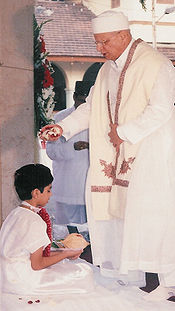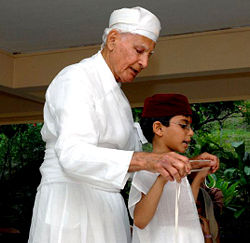
Navjote
Encyclopedia

Zoroastrianism
Zoroastrianism is a religion and philosophy based on the teachings of prophet Zoroaster and was formerly among the world's largest religions. It was probably founded some time before the 6th century BCE in Greater Iran.In Zoroastrianism, the Creator Ahura Mazda is all good, and no evil...
religion and begins to wear the Sedreh
Sedreh
Sedreh is the Avestan term for the undergarment worn by Zoroastrians, which is worn alongside the Kushti.The Sudreh contains a small pocket in the front, which is supposed to collect one's good deeds. It is worn to protect the wearer from evil acts...
and Kushti
Kushti
Kushti is the sacred girdle worn by Zoroastrians around their waists. Along with the Sedreh, the Kushti is part of the ritual dress of the Zoroastrians....
. The term navjote is used primarily by the Zoroastrians of India (the Parsi
Parsi
Parsi or Parsee refers to a member of the larger of the two Zoroastrian communities in South Asia, the other being the Irani community....
s), while sedreh pushi is used primarily by the Zoroastrians of Iran. Zoroastrians from Pakistan
Pakistan
Pakistan , officially the Islamic Republic of Pakistan is a sovereign state in South Asia. It has a coastline along the Arabian Sea and the Gulf of Oman in the south and is bordered by Afghanistan and Iran in the west, India in the east and China in the far northeast. In the north, Tajikistan...
consisting of both Parsi
Parsi
Parsi or Parsee refers to a member of the larger of the two Zoroastrian communities in South Asia, the other being the Irani community....
s and Iranis use both terms.
The word 'navjote' is a Latinized form of the Parsi Gujarati compound of nav "new" and jote "reciter [of prayer]", "invoker", "sacrificer". The second half of the word is—via Zoroastrian Middle Persian
Middle Persian
Middle Persian , indigenously known as "Pârsig" sometimes referred to as Pahlavi or Pehlevi, is the Middle Iranian language/ethnolect of Southwestern Iran that during Sassanid times became a prestige dialect and so came to be spoken in other regions as well. Middle Persian is classified as a...
zot—an indirect continuation of Avestan zaotar, with /z/ eventually becoming /j/ because /z/ is not upheld in Gujarati. The Persian term Sedreh pushi translates to "Putting on the sedreh," a reference to the main component of the ritual.
Age
Although there is no upper limit to the age of the individual for which the ceremony takes place, in common practice it occurs before a girl or boy reaches maturity. Under no circumstances is it permitted to be done for a child less than seven years of age since the child is expected to comprehend the significance of the event.In Vendidad
Vendidad
The Vendidad or Videvdat is a collection of texts within the greater compendium of the Avesta. However, unlike the other texts of the Avesta, the Vendidad is an ecclesiastical code, not a liturgical manual.-Name:...
18.54, individuals above the age of 15 (once considered the age at which one attained adulthood) who are not yet been invested are said to be likely to fall into evil ways. In the 9th-12th century texts of Zoroastrian tradition, the same group are said to be kushad davarashni, literally "running about improperly clothed". So for instance Menog-i Khrad
Menog-i Khrad
Menog-i Khrad is one of the most important secondary texts in Zoroastrianism written in Middle Persian....
2.35 and the Book of Arda Viraf
Book of Arda Viraf
The Book of Arda Viraf is a Zoroastrian religious text of Sassanid era in Middle Persian language,contains about 8,800 words. It describes the dream-journey of a devout Zoroastrian through the next world. Due to the ambiguity inherent to Pahlavi script, 'Viraf' may also be transliterated as...
(25.6.10). The latter considers such a thing to be a service to demons (the daevas
Daeva
Daeva in Avestan language meaning "a being of shining light", is a term for a particular sort of supernatural entity with disagreeable characteristics. Equivalents in Iranian languages include Pashto dêw , Baluchi dêw , Persian dīv , Kurdish dêw...
). Other texts of tradition that define adulthood as the boundary include the Sad-dar 10.1 and Shayast na-Shayast 10.13.
Sacred Kushti (Thread) and Sudreh (Shirt)

The shirt has a construction extremely specific to this culture.
Preparation
Preparation often begins years before, as similar to a Bar Mitzvah in JudaismJudaism
Judaism ) is the "religion, philosophy, and way of life" of the Jewish people...
a basic knowledge of several key prayers must be shown during the ceremony.
The child must bathe in sacred water before the ceremony. This represents a cleansing and purification. A full tray of rice is also placed in the room, to be given to the officiating family priest, after the ceremony. Flowers are also placed in the room, to be given to the assembling guests after the ceremony. A tray bearing a mixture of coconut, pomegranate grains, raisins, and almonds, are in the room as well, and will be sprinkled on the child after the ceremony to symbolize prosperity.
Ceremony
The ceremony is quite intricate, consisting of many recitals of faith and prayer.Like most Zoroastrian rituals, Navjote takes place in the presence of a fire (see Atar
Atar
Atar is the Zoroastrian concept of holy fire, sometimes described in abstract terms as "burning and unburning fire" or "visible and invisible fire" ....
). In the case of this ceremony, which takes place in a public place, the fire is not sanctified and following the event it is allowed to die out.
The Navjote ceremony itself comprises three parts: Patet Pashemani, Din no Kalmo and Investiture of Sedreh and Kushti, and Tan Darosti.
The Patet Pashemani is a traditional prayer of repentance and is recited by the priest on behalf of the person being initiated.
The sedreh is then slipped on the to initiate's forearms while reciting Yatha Ahu Vairo
Ahuna Vairya
Ahuna Vairya is the Avestan language name of the most sacred of the Gathic hymns of the Avesta, the revered texts of Zoroastrianism....
. The initiate then recites the Din no Kalmo (recitation of Faith to the Zarthusti religion). With another Yahta Ahu Vairyo prayer the sedreh is put onto the initiate. The priest then stands behind the initiate and starts the opening stanzas from the Hormuzd Yasht. The initiate then joins in and prays the Hormazd Khodai and Jasme Avangeh Mazda prayers.
The initiate is then seated and garlanded. The priest then recites the Tan Darosti (blessings and good wishes) prayer where for the first time the appropriate prefix (behdin, osta or osti) is used (see below) for the initiate. Persons who have not yet had a Navjote are accorded the prefix Khurd.
Following the ceremony, the child is viewed as a member of the Zoroastrian community, bearing responsibility with its rewards and repercussions. An individual from a lay family is addressed in the liturgy as a behdin, "follower of the [good] religion". This may be distinguished from the title for a member of a clerical family who is henceforth addressed as an osta (for males) or an osti (for females). This does not change unless the individual actually joins the priesthood.

